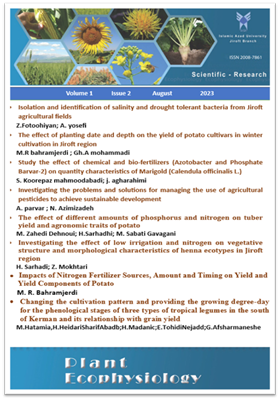-
-
List of Articles
-
Open Access Article
1 - Isolation and identification of salinity and drought tolerant bacteria from Jiroft agricultural fields
زینب فتوحیان احمد یوسفی -
Open Access Article
2 - The effect of planting date and depth on the yield of potato cultivars in winter cultivation in Jiroft region
محمد رضا بهرام جردی غلامعباس محمدی -
Open Access Article
3 - Study the effect of chemical and bio-fertilizers (Azotobacter and Phosphate Barvar-2) on quantity characteristics of Marigold (Calendula officinalis L.)
سهیلا کوره پز محمود آبادی جابر آقا رحیمی -
Open Access Article
4 - Examining the problems and solutions for managing the use of agricultural pesticides to achieve sustainable development
نجمه عظیمی زاده عباس پرور -
Open Access Article
5 - The effect of different amounts of phosphorus and nitrogen on tuber yield and agronomic traits of potato
مجید زاهدی دهنوئی حسن سرحدی مهدی ثباتی گاوگانی -
Open Access Article
6 - Investigating the effect of low irrigation and nitrogen on vegetative structure and morphological characteristics of henna ecotypes in Jiroft region
حسن سرحدی زهرا مختاری -
Open Access Article
7 - Impacts of Nitrogen Fertilizer Sources, Amount and Timing on Yield and Yield Components of Potato
محمد رضا بهرامجردی -
Open Access Article
8 - Changing the cultivation pattern and providing the growing degree-day for the phenological stages of three types of tropical legumes in the south of Kerman and its relationship with grain yield
محمد حاتمی حسین حیدری شریف آباد حمید مدنی عنایت الله توحیدی نژاد غلامرضا افشارمنش
-
The rights to this website are owned by the Raimag Press Management System.
Copyright © 2021-2025







